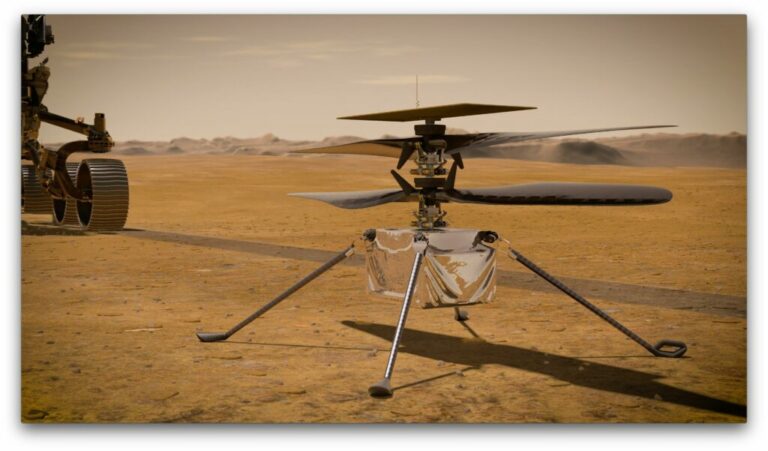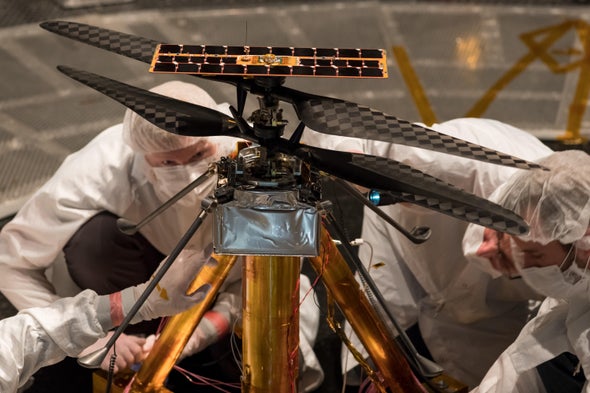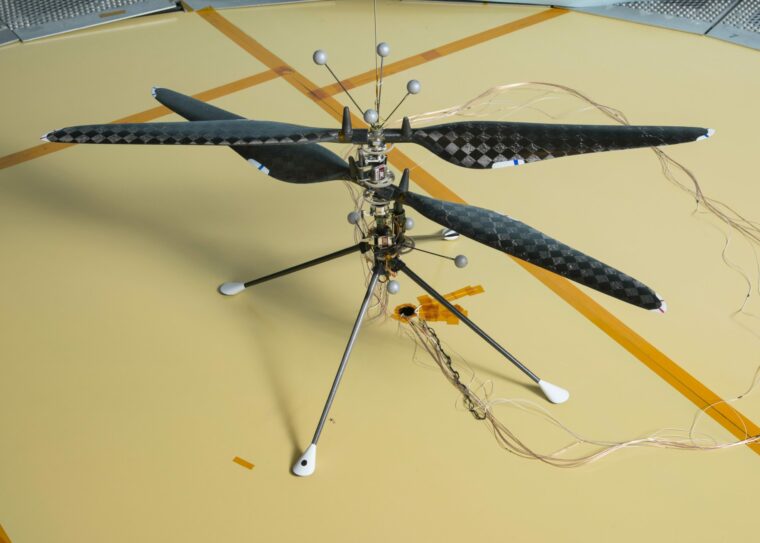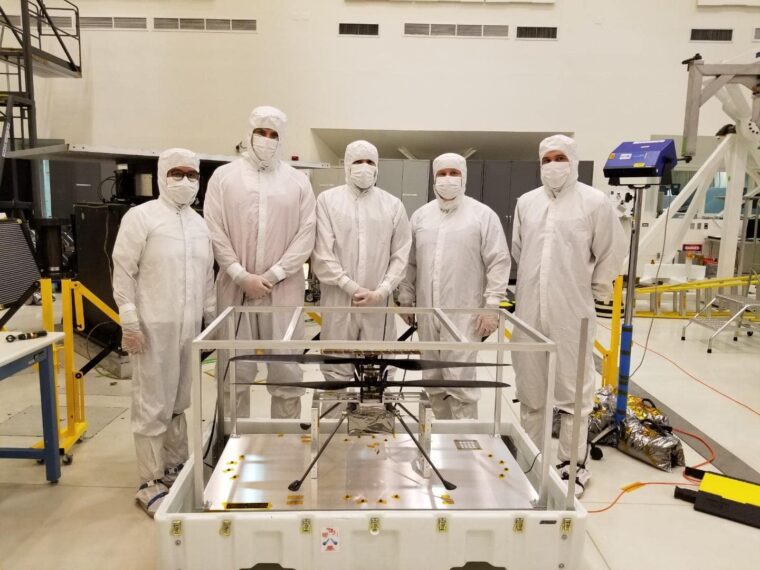
Leading up to the February 18th landing of the Mars Perseverance rover, a lot has been written about the craft’s lone passenger, the Ingenuity Helicopter drone. Ingenuity is, without a doubt, the first of its kind. The Debrief was given the chance to sit down with NASA’s Jaakko Karras, the roboticist who built it, and talk about the first off-world aerial vehicle.

Christopher Plain: First Jaakko, I just wanted to thank you for taking a full thirty minutes out of your schedule to sit down with us, especially considering the enormous weeks and months ahead.
Jaakko Karras: My pleasure, Chris.
What is your personal background, and what brought you to this particular project?
I am a robotics engineer in the robotics section at JPL. I got involved with the Mars helicopter almost four years ago because it’s just a historic project. Also, a particularly fascinating project from a robotics standpoint.
Did you ever think you’d be flying a robot on another planet?
(Chuckles) You know what? Flying a robot on another planet, operating a robot on another planet, certainly was the goal when I first came to JPL. That was something that always fascinated me when I was a student studying robotics. But specifically flying a helicopter on another planet, I don’t think I could have imagined being a part of that.
Did your alma mater, Harvey Mudd, have a virtual 10 year reunion last year, and if so, did you rub your classmates’ noses in your incredibly cool job?
I’ve certainly been in touch with all of my old classmates over the years, describing the operating of the helicopter, and you’re right, the general response has been incredible.
How was the name Ingenuity chosen?
It came out of a naming competition. There was an essay writing contest, and an essay written by a high school student. She did an excellent job, so her essay was selected as the winner, and she named the helicopter.
Does the craft have a nickname among the team?
Before it was officially named Ingenuity, the helicopter was internally referred to as Leonardo, in reference to Leonard Da Vinci’s sketches (of original helicopter designs).
When was the concept of this type of drone first proposed?
The work actually began in the 90’s. Our current chief engineer Bob Balaram had this idea of operating a rotor craft on Mars. So, he started early experiments to demonstrate that you could in fact generate real lift with a rotor blade, operating within the thin Martian atmosphere.

Is it true that it is about 1% of the Earth’s atmosphere?
That’s right. Very, very thin.
Was this project in competition with other proposals, or was it always the next in line for these types of lander missions?
There are always lots of interesting concepts that compete for the opportunity to fly. But this project really picked up steam in about 2014. There was an effort at the time to demonstrate the ability to take off, to generate lift, with a small prototype flying in a vacuum chamber. That’s when it got the attention of upper management and NASA leadership, and started to really become serious. We’ve been pursuing it since then.
In late December, NASA released a video depicting the extremely dangerous and complex descent and landing that the Perseverance will undertake, a video they referred to as the “Seven Minutes of Terror”. I wrote a piece on this video for The Debrief and was personally struck at just how complex this series of actions needed to land the rover and her suite of instruments on the surface safely really was. How much danger is the Ingenuity helicopter drone in during this descent, and what type of shielding or protection does it have?
You’re absolutely right. The landing on Mars is always challenging. We’ll be following that closely. The helicopter is really just tucked in for the ride. It is protected by what is referred to as a debris shield. It is a cover that just encapsulates the helicopter in the belly of the rover, so it doesn’t get hit with debris as the rover is coming down on the surface.
Because Ingenuity was added to the mission so late, engineers had to make room for it to join the trip. Was the debris shield also something that had to be added last minute?
The exact mounting scheme of the helicopter on the rover was an ongoing discussion for quite some time, with many proposals as to where to put it. At the end of the day, putting it there on the belly of the rover just turned out to be the best place to put it. There’s space there, it’s a relatively easy place to deploy it from. Of course, putting it on the belly, the way the rover comes down, facing the planet’s surface means there is the potential for there to be little rocks and such thrown up off of the surface, so that necessitated putting on the debris shield. It’s actually a composite structure, making it very, very light.
Once the entire Perseverance craft is on the surface, what sort of checks will it go through?
After the rover lands, the first thing it is going to do is a sequence of commissioning activities for itself, just to make sure all of its subsystems are healthy and operational. That will span a number of weeks. But, once the rover has established that it is healthy, it’s going to embark on a process of finding the area where it’s going to deploy the helicopter. So, we’re going to be looking for a flight zone, a region that’s good to fly in. So, we’re looking for relatively flat terrain, we don’t want crazy inclines, and we’re looking for terrain that is free of large rocks. That said, we also don’t want a terrain that’s too boring.
Why is that?
Terrain texture is part of our virtual navigation software. So, (Perseverance) is going to identify a flight zone that satisfies those requirements, and then it’ll drive into that flight zone and go through approximately 10 Sols, or Martian days, of the deployment sequence.

So, before Perseverance itself gets to any of its own science missions, its real first job is to get the Ingenuity helicopter to the optimum location to run its missions?
Yes. The helicopter experiment is at the top of the list.
Once on the ground, are there a separate series of checks for Ingenuity before it can begin the mission?
Like the rover, the Ingenuity helicopter has a stand of commissioning activities. One of the first things is a general check of the health of the avionics, of the solar array, and the thermal control system. This will be the first time the Ingenuity helicopter is its own standalone spacecraft. There’s just a lot of check out, making sure it’s able to generate enough power, able to keep itself warm overnight, that the avionics are healthy. Once that’s done, there will be a sequence of checkouts of the actual rotor system. One of the first things that has to happen is, the rovers actually have to be free. The rover was launched in basically a restraint mechanism to protect the actuators from vibration during launch. SO the helicopter has to do a simple sequence to release those so that the blades can rotate. And then there will be a sequence of low speed rotor spin to verify the health of all of the actuators. There will be a higher speed spin, and then at that point, we should be in good shape to try and start to fly.
That sounds amazing.
Yeah, everything about this helicopter is one of a kind design. There’s a lot of stuff here that’s simply without precedent. Even in the commissioning activities, it will be our first glimpse into how these systems perform on Mars. The successful completion of even one of these steps is a milestone for us.
Before we take flight, could you describe the hardware and software that make up Ingenuity?
One thing I’d really like to point out about the helicopter. It really sits at the intersection of three key areas of design constraint. So on one hand it had to be a helicopter that could fly in the thin atmosphere, but it also has to be a standalone spacecraft. It has its own power, its own thermal, and lastly it has to be autonomous because of the timing lag on Mars there’s no way to operate the helicopter manually. What all of this really means in the terms of design is, the helicopter had to be very, very compact, and be very, very light weight. So, it brings in a lot of design elements that have really never been used before. We used a lot of composite materials, all of the airframe, the blades, they’re all composite.
That’s for weight reasons?
Weight and stiffness. The avionics also have to be very, very compact. They’re very light. But there’s also this autonomy software element; the avionics have to be very high performance. So, one thing that’s interesting there, the helicopter avionics actually use a lot of components you would find in your cell phone.
Like what?
The main processor, for instance, is a smartphone processor. Why that’s interesting is, it’s not what is typically used in spacecraft design. But in our case, it’s the only option for us. That’s where we find high compute performance in a very small, lightweight package.
So, in this particular case, the commercial market created something you were able to use in a science mission?
Exactly. The commercial market has done an excellent job miniaturizing and packing in the level of performance that we actually need. The cameras as well. The helicopter has visual application software, and it’s doing that through potentially smartphone type cameras. Once again, that’s because they are very compact, very light weight, and provide a very high level of imaging performance. All of these construction choices are, I think, very, very exciting aspects of this helicopter.
How is Ingenuity controlled?
The actual day-to-day operations of Ingenuity will be controlled through parameters that get uploaded to it. So, the core software framework is already in place, but it does accept parameters for things like when it’s waking up, the exact flight that it’s going to perform, and so on. So there will be a daily analysis by the team to set the parameters for the rover the following Sol.
How many missions are already planned for Ingenuity, and what is the length of time for its initial tour of duty?
There are five planned flights. And I think you really hit the nail on the head. Ingenuity is a technology demonstration, so the goal is to demonstrate that we can fly on Mars. And if it is successful, the hope is that we will return to Mars with larger rotor craft that will be their own standalone missions. There won’t be a rover to hover around. Those rotorcraft will be able to cover all kinds of terrain, and unlock all of these new science targets that ground based rovers aren’t intended to be able to access.

What is Ingenuity’s range?
For all of our five scheduled flights, we’ll be flying at altitudes of only about three, four, maybe five meters. In terms of range, for operating in this flight zone, spanning tens of meters, in general staying about a hundred meters away from the rover. All of these, the altitude and the range, they’re not constrained by the aerodynamics of flying on Mars. It could fly higher. It could certainly fly farther away from the rover, but because of the nature of the tech demonstration we actually need to stay near the rover so we can communicate through the rover.
Legacy rovers like Spirit and Opportunity significantly outlived their original missions. If Ingenuity is similarly lucky, are there a set of follow up missions to the original series ready to go?
In the case of Ingenuity, its experiment is designed to be 30 Sols long, and that’s what it will be. That’s because the rover itself has to get on with its mission and its science objectives. The 30 Sols is not limited, we hope, by the longevity of the hardware, it’s just a scheduling constraint.
Given the results of this mission, are you saying this mission could set the stage for a whole new way to explore planets?
Yes. It is very analogous to the Pathfinder rover of the late 90’s, where once Pathfinder demonstrated that you can operate a small rover on Mars that just opened up to larger, more complex missions.
Are there any lucky-charms or secret messages the engineers have placed aboard Ingenuity?
(Chuckles) Not that I know of. As engineers, every line of code, every little dimension, every little design cue is…we take out work very personally, and I like to think of the design itself as a composite of everyone that has been on the team.
That is your signature?
Exactly.
At what point in this series of steps do you and the members of the Ingenuity team break out the champagne?
Certainly that first flight will be historic. However, I will say that as enormous of a milestone as that first flight is, we won’t have much time to celebrate because we will be planning for the second, third, fourth, fifth flight. So, I think the celebration will have to wait until the end of the 30 day, 30 Sol flight experiment.
The Debrief will be doing a live YouTube broadcast of the landing on the 18th, and will be rooting for your success. Should fans of Ingenuity be looking for something specific?
I would just emphasize the significance of all of this. This will be the first flight on another planet. A Wright Brothers moment, but on Mars. Longer term, we really do believe that this technology, if successful, will unlock the aerial dimension of exploration on Mars. Sort of fill in the gap between rovers that are right on the surface with a one meter vantage point, to orbiters that are hundreds of kilometers above the surface. There’s this whole layer in between, where if you had a rotorcraft, you could still be relatively close to the surface like the rovers are, but cover so much additional terrain. Also, you can access terrains that a rover isn’t suited for. We’ve been on Mars for a while now, and we know about all of these tantalizing sites. Steep cliffs, lava tubes with skylight openings, and other features we think will be tricky to access, because of the potential bio-sensitivity. All of these really compelling science targets we hope will be unlocked with an aerial vehicle that can access those in ways we haven’t been able to access before, and really shed new light on all of the science inquiries that we’re pursuing on Mars. We hope this will open a door to all of this new compelling science and exploration.
Well, thanks again for your time, Jaakko, and good luck next week.
Thank you, Chris.
No comments:
Post a Comment
Note: Only a member of this blog may post a comment.